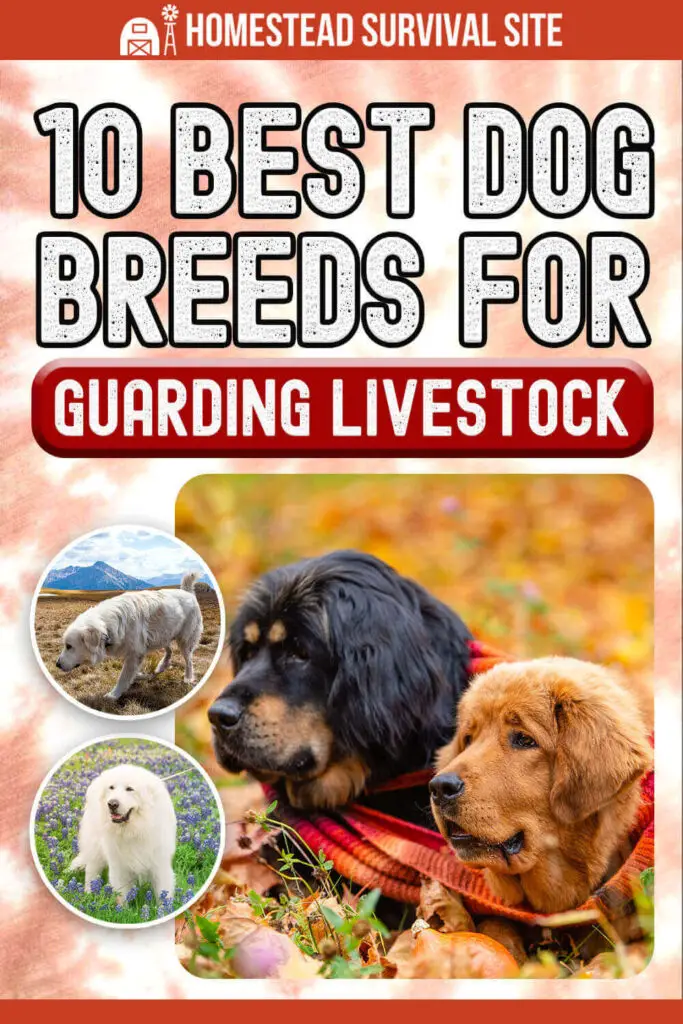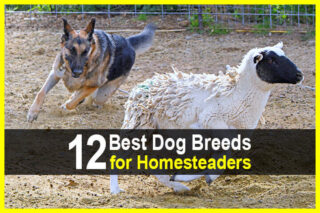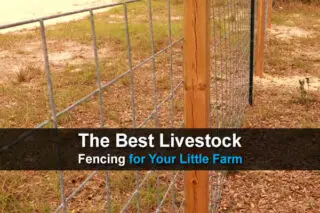Estimated reading time: 8 minutes
Livestock guardian dogs can protect your livestock from both four-legged predators and two-legged threats both now and especially during an SHTF scenario. The dedicated canines will alert you to potential threats and fight to the death to protect their barnyard wards.
While most any breed of dog will bark and attack when they sense a threat, livestock guardian dogs go a step beyond that. They are bonded to the animals on your survival homestead and have an innate ability to sense danger before it gets close enough to eat or steal the protein you are raising.
Even if you spend a host of time and money hardening your barnyard stalls, pens, coops, and hutches against homestead predators, they still have a way of getting in – or attacking during broad daylight when the animals are in the pasture.
Buying a livestock guardian dog will not completely eliminate the threat of human and animal predators, but it will provide you with the strongest deterrent possible – unless you plan on sitting in the barnyard with a rifle 24/7.
Want to save this post for later? Click Here to Pin It on Pinterest!
Livestock guardian dogs (or LGDs) work best in pairs. It really does not matter if it is a male and female or two same-sex or same litter pairs. But, if you would like to make some extra money for your preps, consider buying a breeding pair and selling the puppies – but maybe keep a pup as a backup in case you lose an LGD to a predator or illness.
LGDs do not limit their efforts to protect their livestock to the ground. The dogs will chase away birds of prey like hawks whenever they come circling around or attempt to land and steal a chicken.
A guardian dog’s first instinct is not necessarily to attack. While they frequently patrol the perimeter of their territory, they will try to scare away a predator with barking and growing before it can get close enough to cause harm.
Livestock dogs will strike as imposing a posture as possible to prevent the need to move away from their charges, but they will not hesitate to attack viciously if the coyote, mountain lion, bobcat, fox, snake, bear, or human being refuses to leave it’s territory.
Top 10 Livestock Guardian Dog Breeds
1. Great Pyrenees
This dog breed is the one most often associated with prime livestock guardian dog traits. The Great Pyrenees is the most popular barnyard dog on a nationwide scale. They appear to be gentle giants and remain true to that label, until a predator poses a threat to the barnyard.
The Great Pyrenees is hardy in cold weather due to their thick coat, but would not be a great choice for survival homesteads located in extremely humid or tropical climates. During the summer months, keep a baby pool in the barnyard for this type of livestock guardian dog if a pond is not accessible within their primary territory. These dogs are docile and get along well with children.
2. Kuvasz
These dogs are perhaps the most avid attack dogs of livestock guardian breeds. They are almost always suspicious of any human stranger and prone to go into warning, guard, and attack mode quickly. Kuvasz dogs hail from Hungary, making them also cold weather hardy. They are an extremely agile breed and speedy runners, even over rugged terrain.
This type of livestock guardian dog is often prone to maintaining a larger protection area around the barnyard and more eager to attack long before a predator can get within striking range of your barnyard animals.
A Kuvasz can go from being affable and docile around its family to viciously warning a potential threat that it can come just so close to into the dog’s territory, but absolutely no further.
3. Pyrenean Mastiff
This Spanish Mastiff breed is a suspicious sort, never trusting any stranger – on two legs or four. The Pyrenean Mastiff is docile with children, at least children that it knows. Expect less non-threat assessment barking from this livestock guardian breed than any other, especially during the training stage.
4. Maremma Sheepdog
This Italian dog breed is small on a livestock guardian scale (70 to 100 pounds) but don't let its size deter you from considering it for your barnyard. A Maremma Sheepdog is just as determined to back down large deadly predators as any on LGD breed. They are docile with the family that keeps it, but they don't show as much affection as other livestock guardian breeds – unless they choose to initiate it themselves.
5. Komondor
This Hungarian dog breed has an extremely thick coat and fur that resembles dreadlocks. The thick coat helps to protect this livestock guardian dog during deadly battles with sharp-toothed predators. Proper maintenance of the coat is quite necessary or it will become incredibly tangled and mangy. The Komondor breed loves getting attention from its humans and the other animals on the homestead.
6. Tatra Sheepdog
The Polish Tatra Sheepdog is also what is part of a group of large guardian dogs commonly referred to as “mountain dogs.” They are gentle giants, until they sense a threat. Unlike some top livestock guardian dogs on this list, they are most welcoming when it comes to strangers that do not appear to pose a threat.
These sheepdogs almost constantly pace around the perimeter or the barnyard or a herd out in the pasture, watching for a threat and getting ready to fight if they cannot scare it away. A Polish Tatra Sheepdog can go long periods of time without the need for human contact due to their breeding to care for sheep in remote areas sans human intervention.
7. Spanish Mastiff
This livestock guardian breed is among the largest and best known to kill wolves. A mature Spanish Mastiff typically weights between 185 to 220 pounds. Like the Great Pyrenees, its thick coat makes these Spanish LGDs extremely cold hardy but not prime candidates for climates with exceptionally hot or humid summer weather.
This mastiff breed can be a bit standoffish from a human affection standpoint but are well-behaved and affable with their keepers.
8. Karakachan/Bulgarian Shepherd
This is another small (70 to 110 pounds) livestock guardian dog breed. The Karakachan Shepherd hails from Bulgaria. They are a decidedly calm and focused livestock guardian dog breed. These watchful canines are often praised for how dedicated and affectionate they are with their keepers. Karakachan Shepherds have been used as watchdogs for the Bulgarian Army.
9. Anatolian Shepherd
These Turkish livestock guardian dogs are a stocky lot with a loud and deep bark. The Anatolian Shepherd is praised for both its agile nature and its intelligence. They are cold hardy dogs that thrive in even the most rugged of terrain.
While all livestock guardian dogs can use training when they are puppies, the Anatolian Shepherd tends to require far less than other breeds. Because they were bred to work alone in isolated areas, these shepherds are highly independent and are prone to hunting wild small game to feed themselves.
10. Tibetan Mastiff
This type of Mastiff is among the largest. The Tibetan Mastiff originated in the mountains of Himalaya and were bred to guard both herds and flocks. This mastiff breed has long been used in Tibet, China, Nepal, and Mongolia to protect medium and large livestock from wolves, leopards, and tigers.
Although docile and decently affectionate with its keepers, the Tibetan Mastiff can be aloof and almost entirely focused on remaining alert at all times.
Livestock Guardian Dog Tips
An LGD is a true working dog. You (and your children) must resist the urge to take the little fur balls into your home as puppies. Their predator protection training begins as soon as they are weaned and it is essential that the livestock guardian dog puppies start living in the barnyard with their protectees as soon as possible.
Until the puppies learn their territory and are large enough to protect themselves from predators, it is recommended to keep them in a kennel in or near the barn.
Although livestock guardian dogs are not known to bond with poultry flocks and rabbits like they do with small and medium livestock, their very presence in the barnyard will provide an added layer of protection for the small animals.
LGDs will rarely ever chase chickens, ducks, or turkeys, but some additional training on this front might be a good idea, just to make certain all of the barnyard inhabitants will live in complete harmony.

There is a big difference between herd dogs and livestock guardian dogs – and both are definitely worth keeping on your prepper retreat or survival homestead. A herd dog bonds with its keeper and not the barnyard livestock.
A Blue Heeler and similar quality herd dog breeds are focused on helping their keeper move the livestock from one place to another and not sitting still on watch for hours on end. While a herd dog will fight a threat without hesitation, it will not be content to walk a perimeter all day, it craves action and has two modes – moving at top speed and crashing out until it is called to duty again.
Herd dogs bark frequently in an effort to move the livestock from point A to point B. When a livestock guardian dog barks, it is time to grab your rifle and move rapidly to go render backup.
Like this post? Don't forget to Pin It on Pinterest!











Up in the mtns. of Peru, I saw a lot of pigs next to the Quechuas’ houses. I was told they are guardians, & I believe it. They had full tusks & stood up as soon as I moved by the place.
Swine are the smartest livestock out there. Most will bond w/ their human keepers too. Has anyone ever trained, say, a Russian boar to guard their livestock? One would be a meal for a big bear, but not two. Would they work in concert to fight a threat? Curious.
Interesting idea. I would think they’d be smart enough to work together but to be honest I don’t know of anyone who has actually done this.
I see you’ve been using my image, please let me know asap with what rights.
Thanks and regards,
Adrian Popan
https://homesteadsurvivalsite.com/wp-content/uploads/livestock-guardian-dog-among-sheep.jpeg?ezimgfmt=ngcb1/notWebP
We always get our images from stock images sites, so I’m not sure how this happened, but I went ahead and removed the image. Sorry about that.